The story of the start of the famous Chrysler Parts Division
So what is in a name? When it’s the case of the name “Mopar®,” it is an entire history going back to nearly the beginning of the Chrysler Corporation itself. Mopar is a commonly used word in today’s motorsports and high-performance car scenes but the origins of the term Mopar had absolutely nothing to do with high-horsepower or checkered flags at a racetrack when it first came about. When Chrysler was a young and growing company in the 1920s, it was gaining market share and a customer base (it had bought out the Dodge car company in 1928) and soon the need for a dedicated parts supplier led to the formation of the Chrysler Motor Parts Division.
As the company continued to grow and purchase other car companies, the Chrysler Motor Parts Division featured a simple logo with the letters C, D, D and P (Chrysler, Dodge, DeSoto and Plymouth) from the years 1933 to 1937, and while it did certainly explain a bit about the different divisions of the company, from an advertising point of view it hardly would have been considered a catchy or creative way of marketing a line of replacement parts for Chrysler products.
PRE-MOPAR LOGO
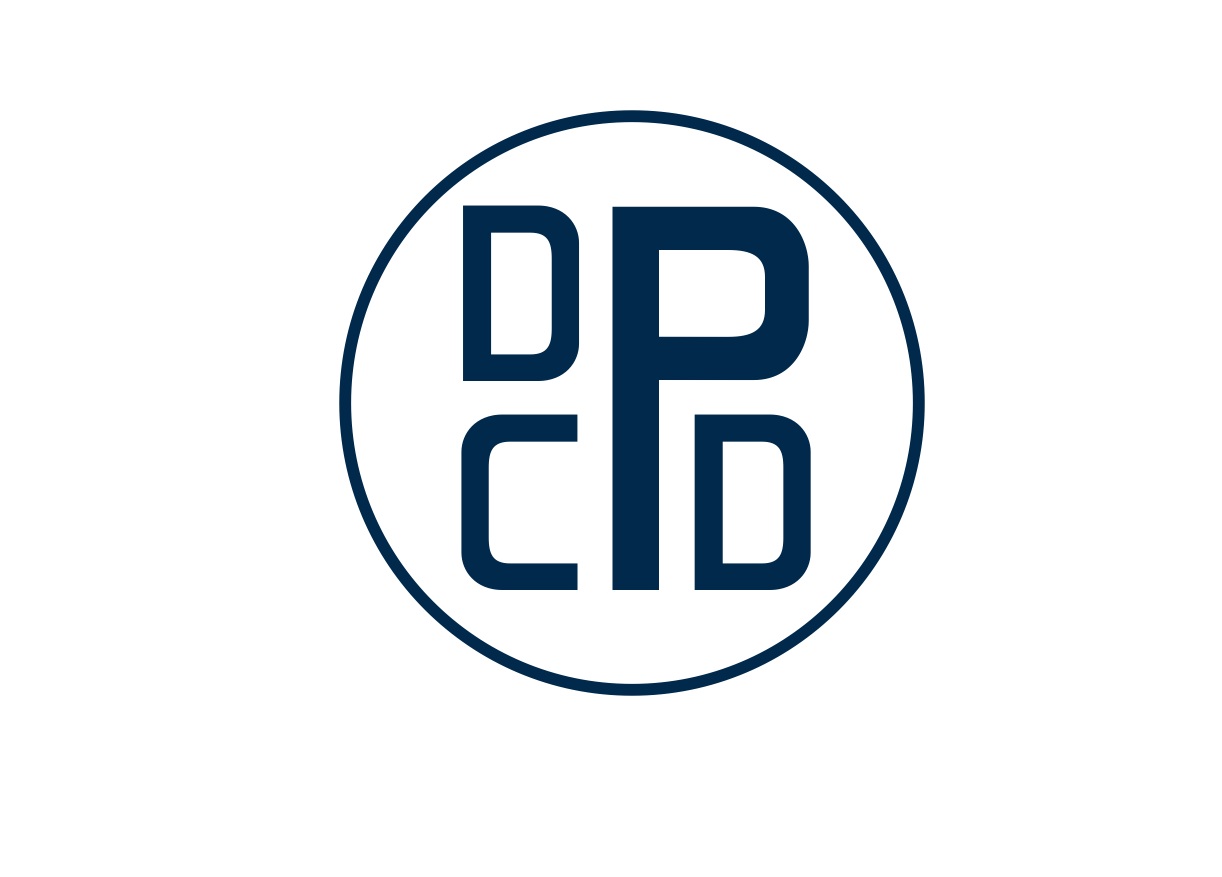
This is the original logo used for the Chrysler Motor Parts Division that was used from 1933-36 and the D is for “Dodge,” the P is for “Plymouth,” the C is for “Chrysler” and the other D is for “DeSoto.” Because there were Imperial models in the Chrysler line between the years 1933-36 as well, some historians believe the long “I” as seen on the oversized P letter was a way to include the use of the Imperial in the logo. While it did certainly explain a bit about the different divisions of the company, from an advertising point of view, it hardly would have been considered a catchy or creative way of marketing a line of replacement parts for Chrysler products. This CDDP logo was replaced with the MoPar insignia, these letters remained on bolt heads and other items such as fan blades, manifolds, etc., for a number of years of Chrysler vehicle production.
It was around this time that a sales promotional manager in the company by the name of Nelson L. Farley decided there had to be a better way of promoting the replacement parts division of Chrysler. He soon got together a group of his people and they created an “Activities Council” within the company to dream up some new ideas that would be more suitable for the identification and the advertising of the factory line of parts and accessories for the four different brands of vehicles Chrysler was then manufacturing.
Company records show that it was in the Spring of 1937 that the results of the Activities Council came to light: the group of people led by Farley came up with a short but to-the-point name of “MoPar,” (a simple contraction of the words MOtor and PARts) and the old parts division was soon to become the MoPar Division and the first order of business was coming up with a logo so they could put the name on cans of antifreeze that were being used in their cars and trucks.
FIRST MOPAR PARTS LOGO
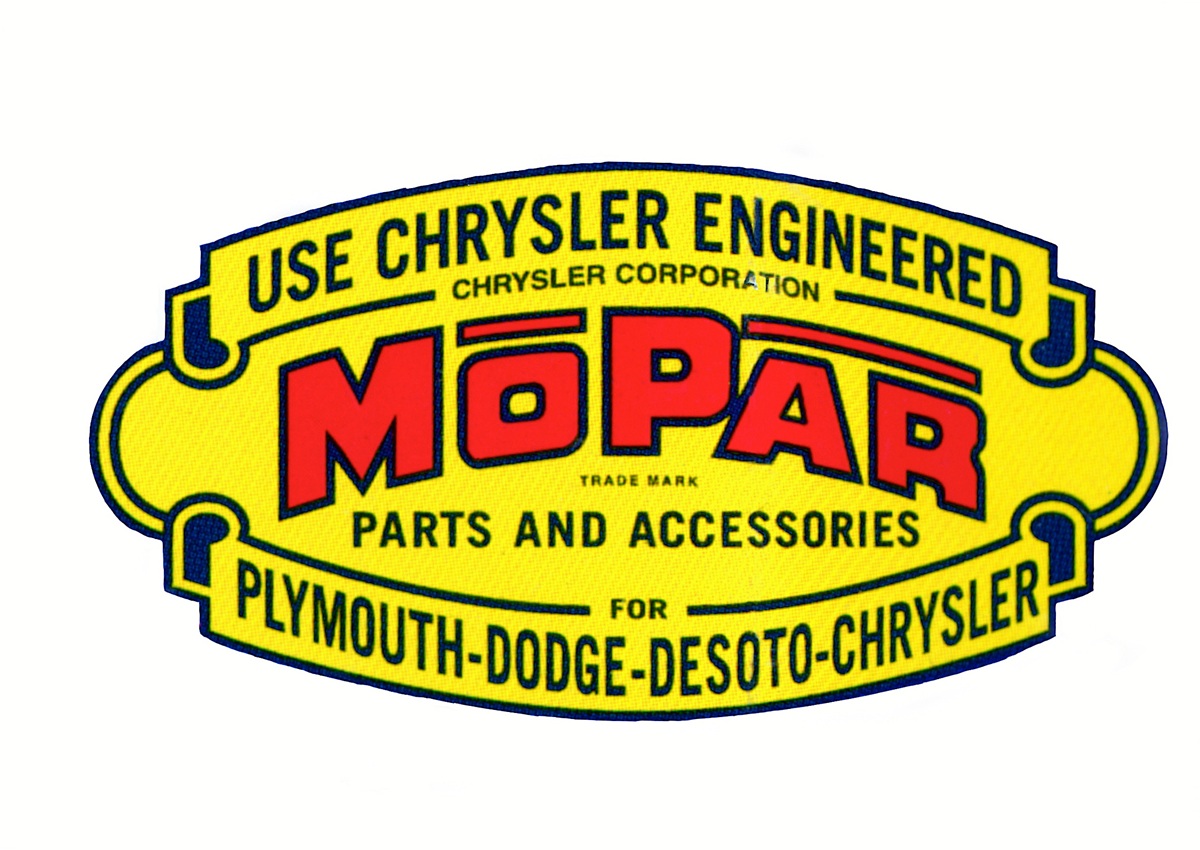
The very first MoPar logo was oval in shape and used the colors yellow and red predominately, and this was a much improved way of identifying these products as compared to the old CDDP method. The new logo and the new name for the parts division, being a short and easy to remember acronym, this was a big move forward in communicating to the customers.
It was the authentic, O.E. (original equipment) quality parts and pieces that were available at any Chrysler, Dodge, DeSoto or Plymouth garage at the time. This timeframe was prior to the start of referring to them as “dealers” for several more years.
It should be pointed out that at this stage of the story, the word or meaning of the word MoPar had absolutely nothing to do with racing or special heavy-duty parts, it was simply a new way of marketing the existing line of parts (plus oil, filters, car wax, etc.) and limited accessories such as floor mats – if you needed something for a Chrysler product and got it from the garage that sells the vehicles, it came marked as a MoPar item.
REVISED LOGO
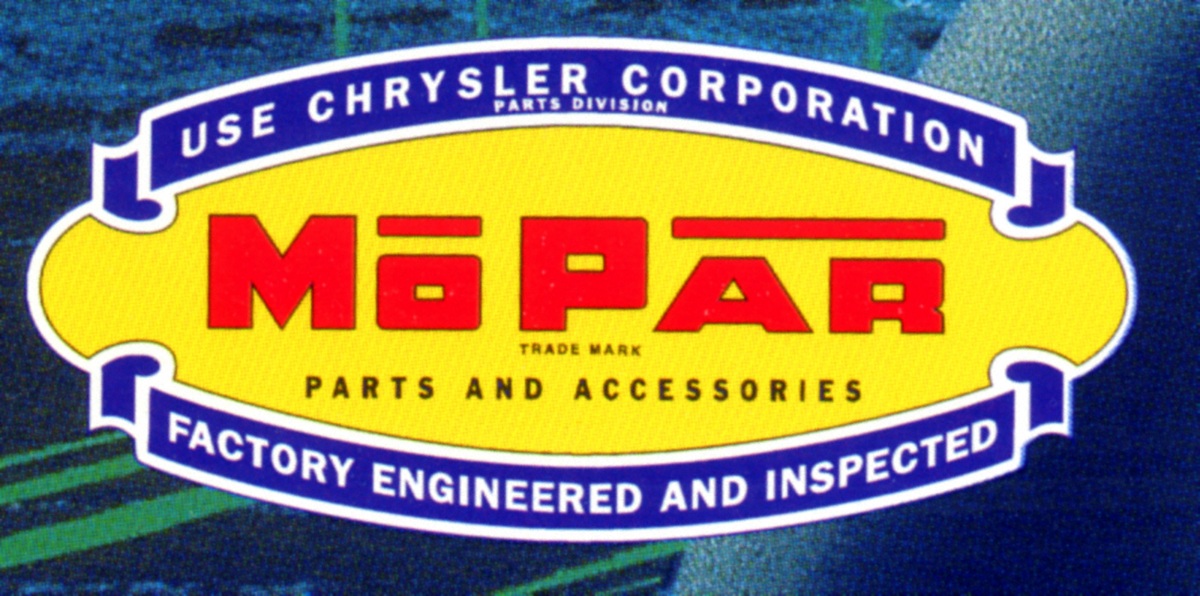
That original MoPar brand and trademark logo remained the same from the years 1937-47 and was slightly changed (for easier name recognition) in 1948, with that second logo, also yellow/red but with some blue hue added, and was not changed for some six years. “Factory Engineered and Inspected” wording was used. Chrysler was going strong during this time (as their overall sales had exceeded that of the Ford Motor Company after WWII) and MoPar went along for the ride. If a consumer needed a set of wiper blades or a replacement fender for their faithful DeSoto, as an example, a visit to the parts department would net these products with MoPar markings on them. Good, high-quality replacement parts, but still nothing too exciting in terms of high-performance or racing! MoPar parts were factory replacement items, nothing more and nothing less.
MOPAR RADIOS
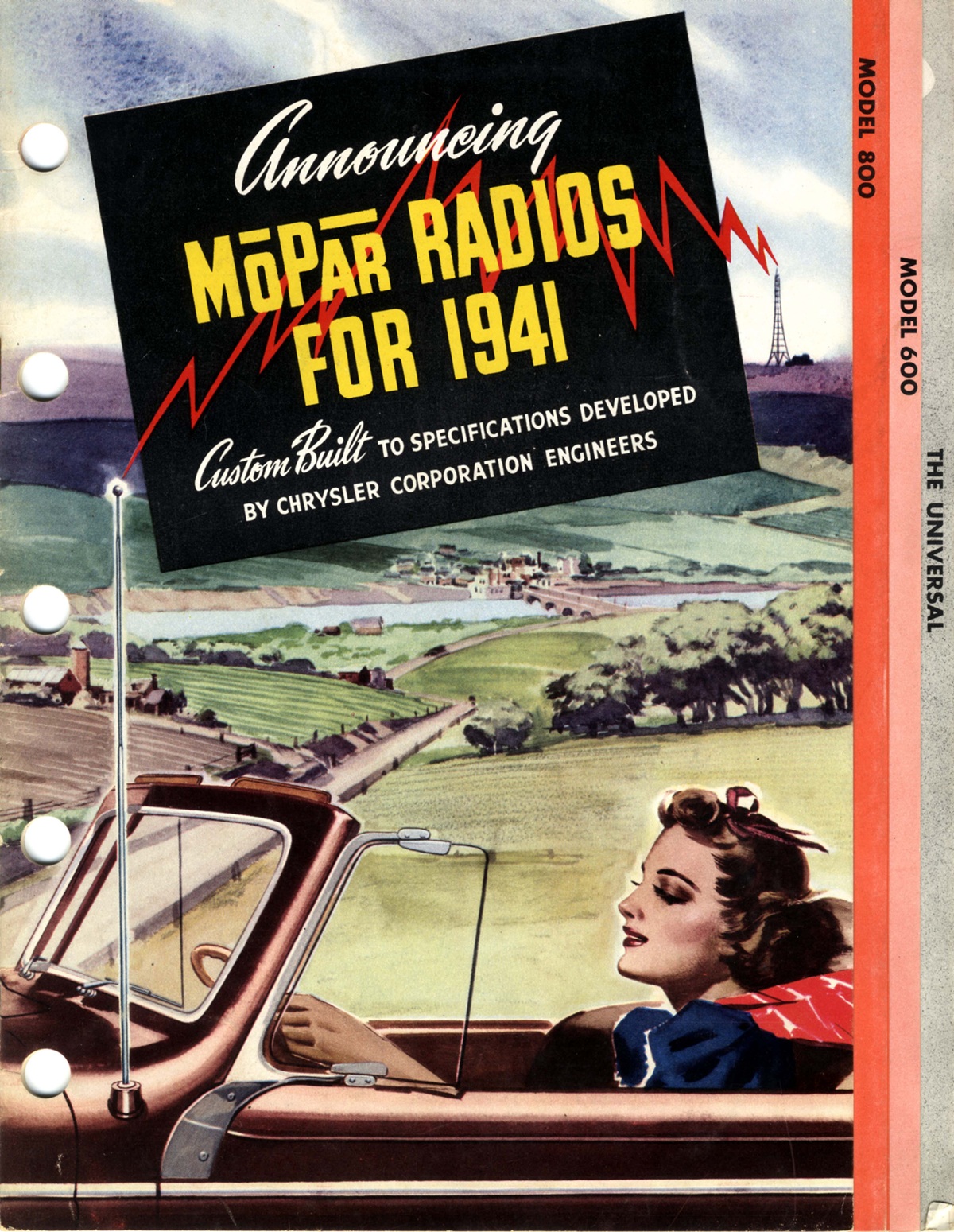
“Automatic push button tuning” was among the features for the MoPar Custom Built Radios (Model 600, 800 and The Universal) as shown with this color brochure from 1941. It shows the antenna mounted on the driver’s side of the vehicle (later moved to passenger’s side).
MOPAR POWER PUNCH PISTON RINGS
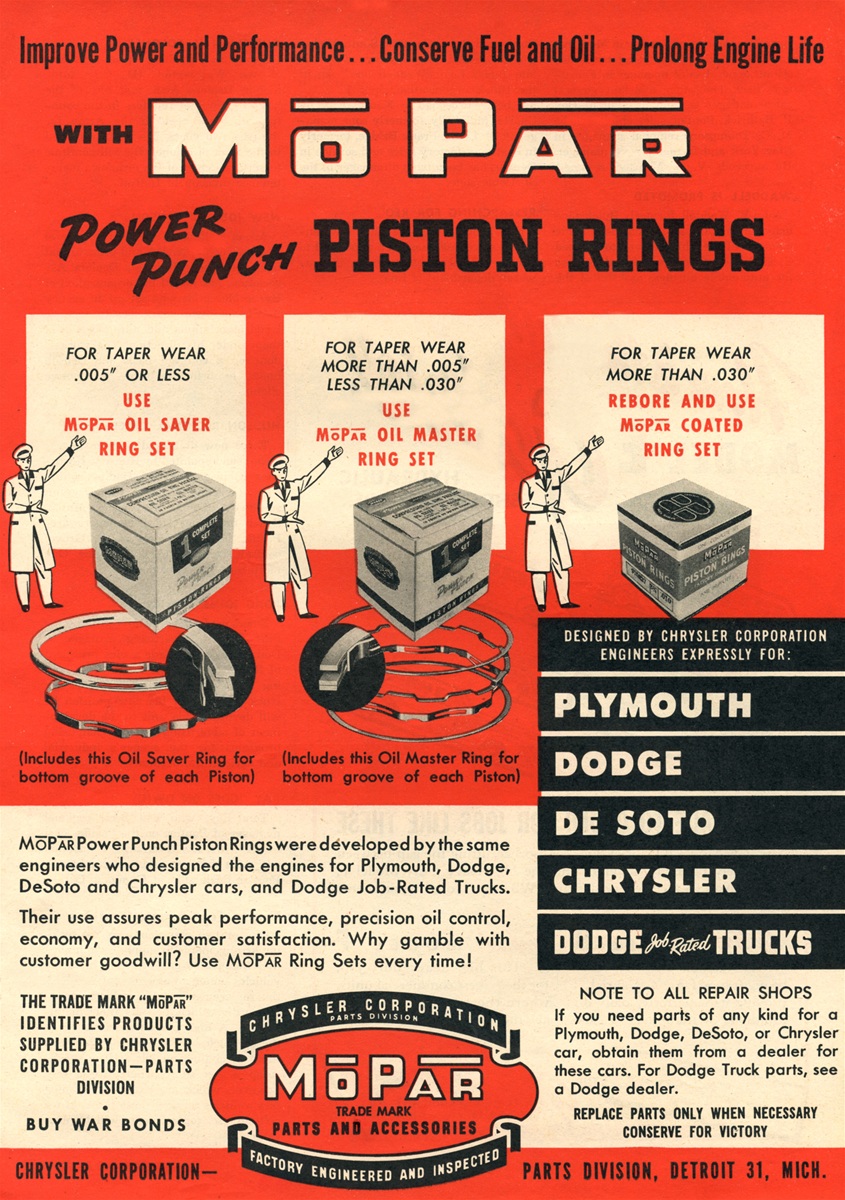
While researching for this article, we were able to locate this early “MoPar Power Punch Piston Rings” ad that appeared in a Motor Magazine from the 1940s, featuring the words “buy war bonds” and a message to “replace parts only when necessary”, and the logo dates the ad somewhere around 1948 (based on Chrysler records of logos used).
MOPAR: THE RIGHT PARTS!
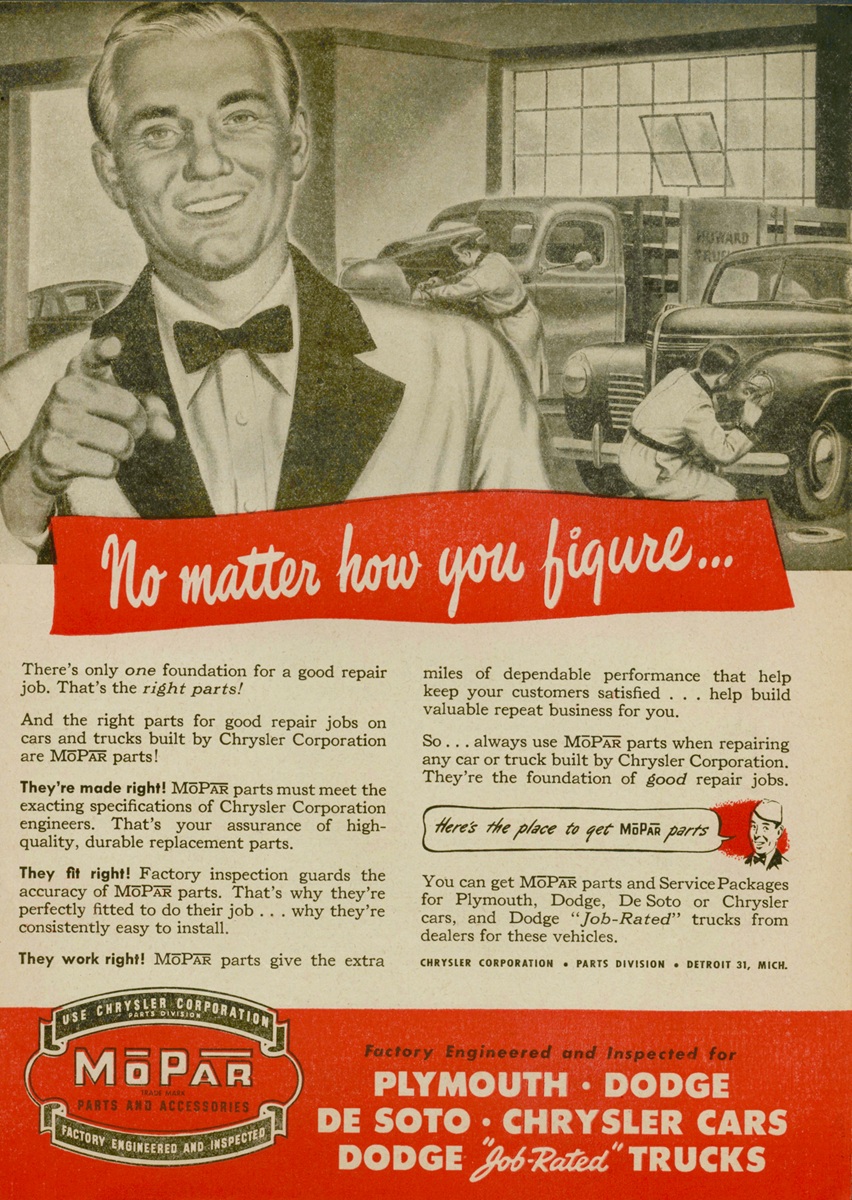
Promoting the use of “the right parts” for good repair jobs on cars and trucks built by Chrysler Corporation, the ink color red was added to this circa 1948 advertisement for extra emphasis. “Always use MoPar parts…that’s your assurance of high-quality, durable replacement parts.”
“Q” FOR QUALITY
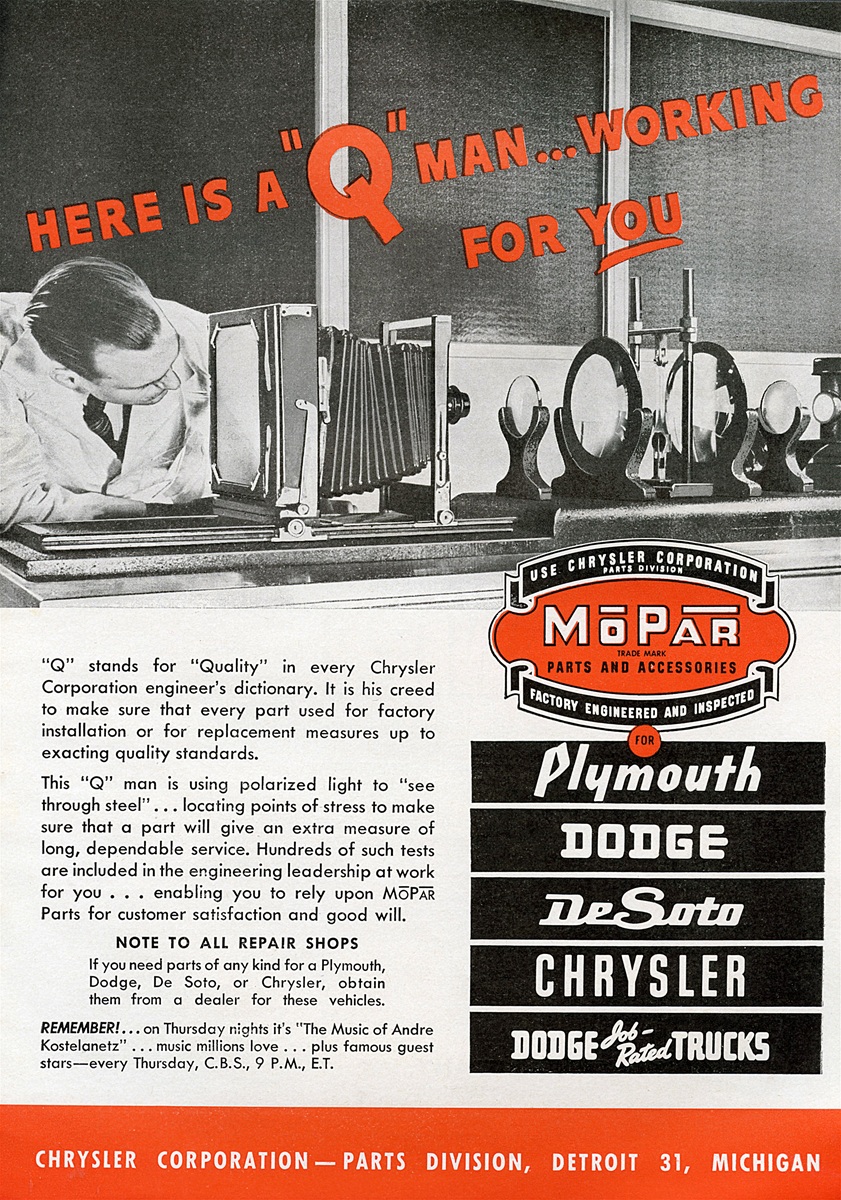
Factory quality control was the basic theme used in this late 1940s/early 1950s MoPar ad talking about the company’s polarized light that is used for metal testing of MoPar replacement parts. Dodge Trucks of this era were marketed as “Job-Rated” trucks as listed in the brand breakdowns.
MOPAR BRAKE LININGS AND ALL ABOUT SAFETY
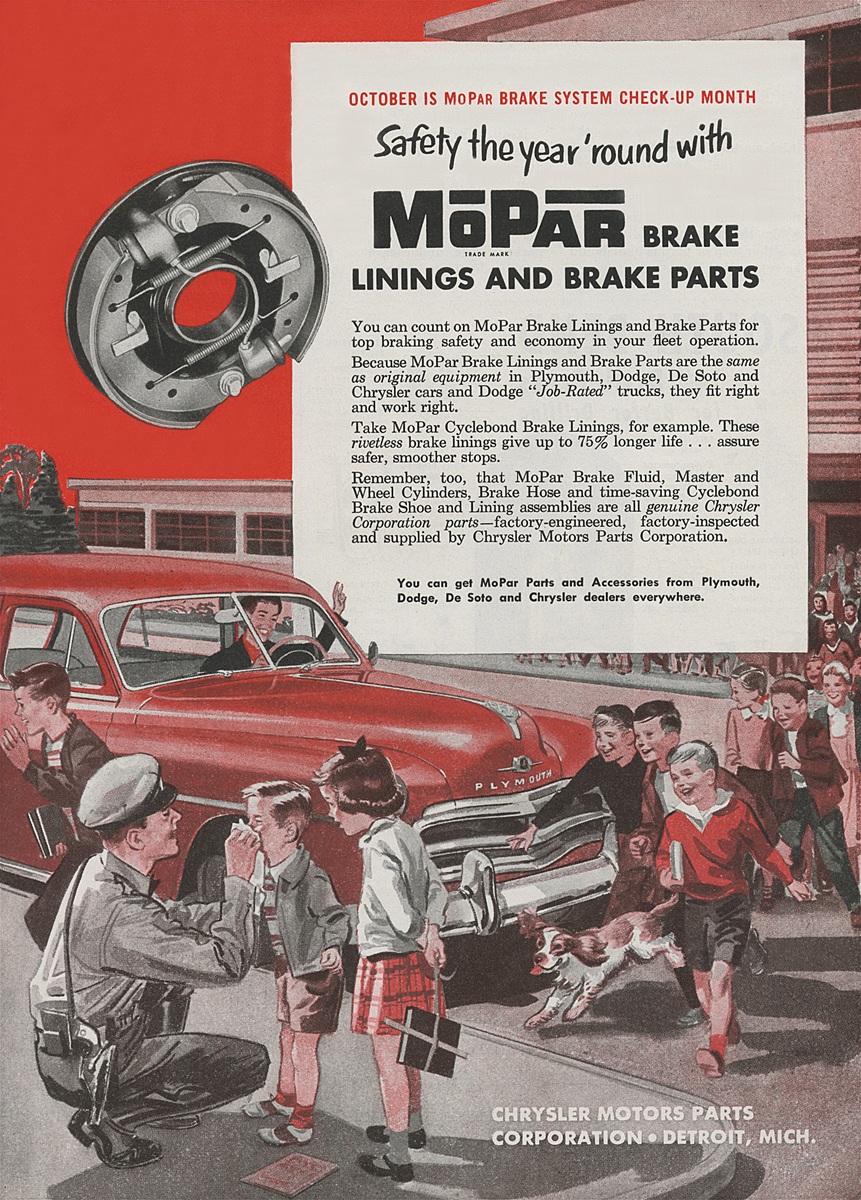
Appearing in the October 1951 issue of Chilton’s MOTOR AGE, this trade advertisement was geared at fleet operation managers to choose MoPar brake linings and parts. A previous model year 1950 Plymouth was featured, and shown stopped in a school cross-walk. Also noted was that October was MoPar Brake System Check-Up Month.
SATURDAY EVENING POST MAGAZINE ADS
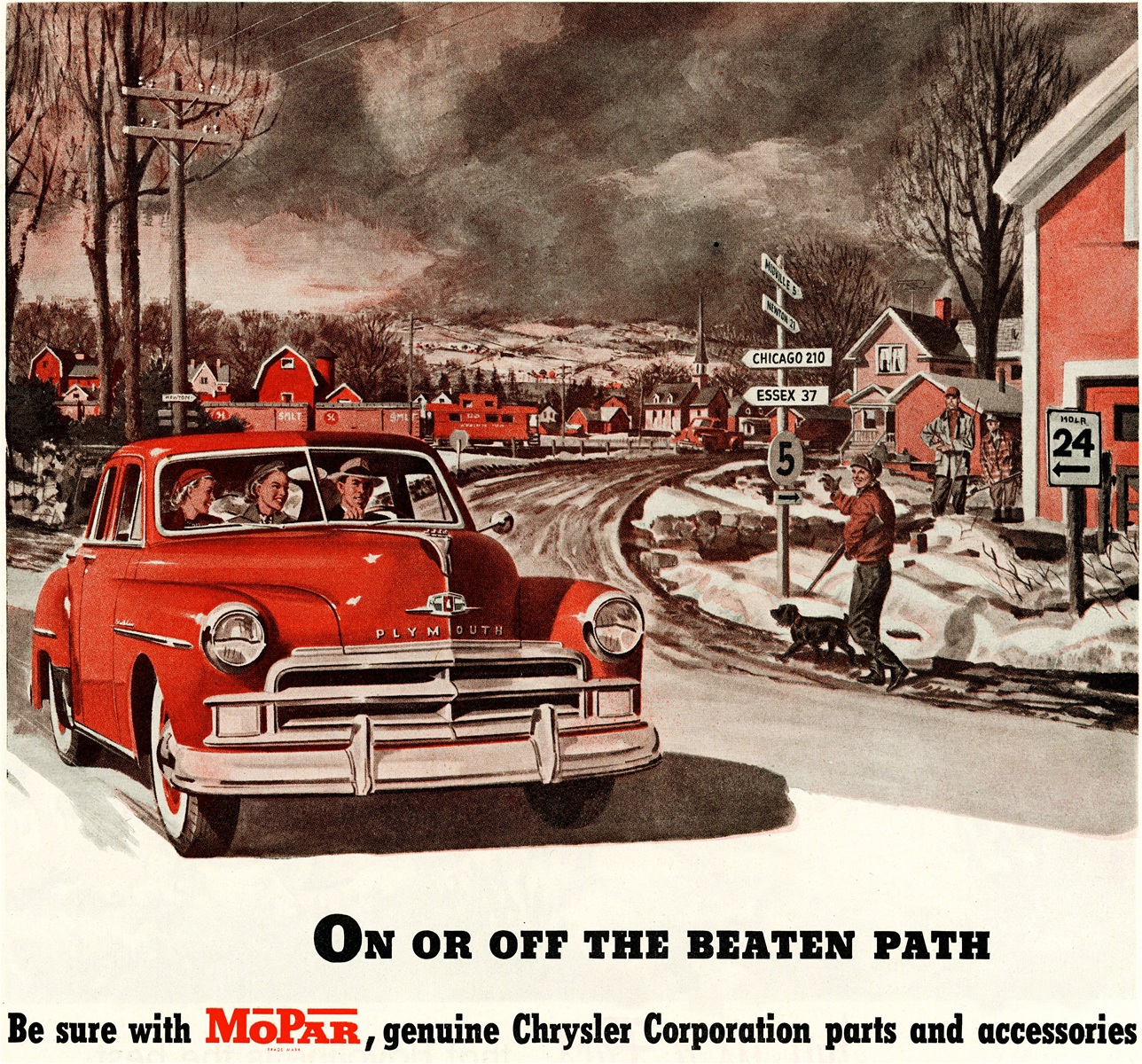
At the time, the Saturday Evening Post magazine was a weekly general interest consumer news publication, and Chrysler Corporation chose it to publish numerous advertisement promoting the MoPar line of replacement parts.
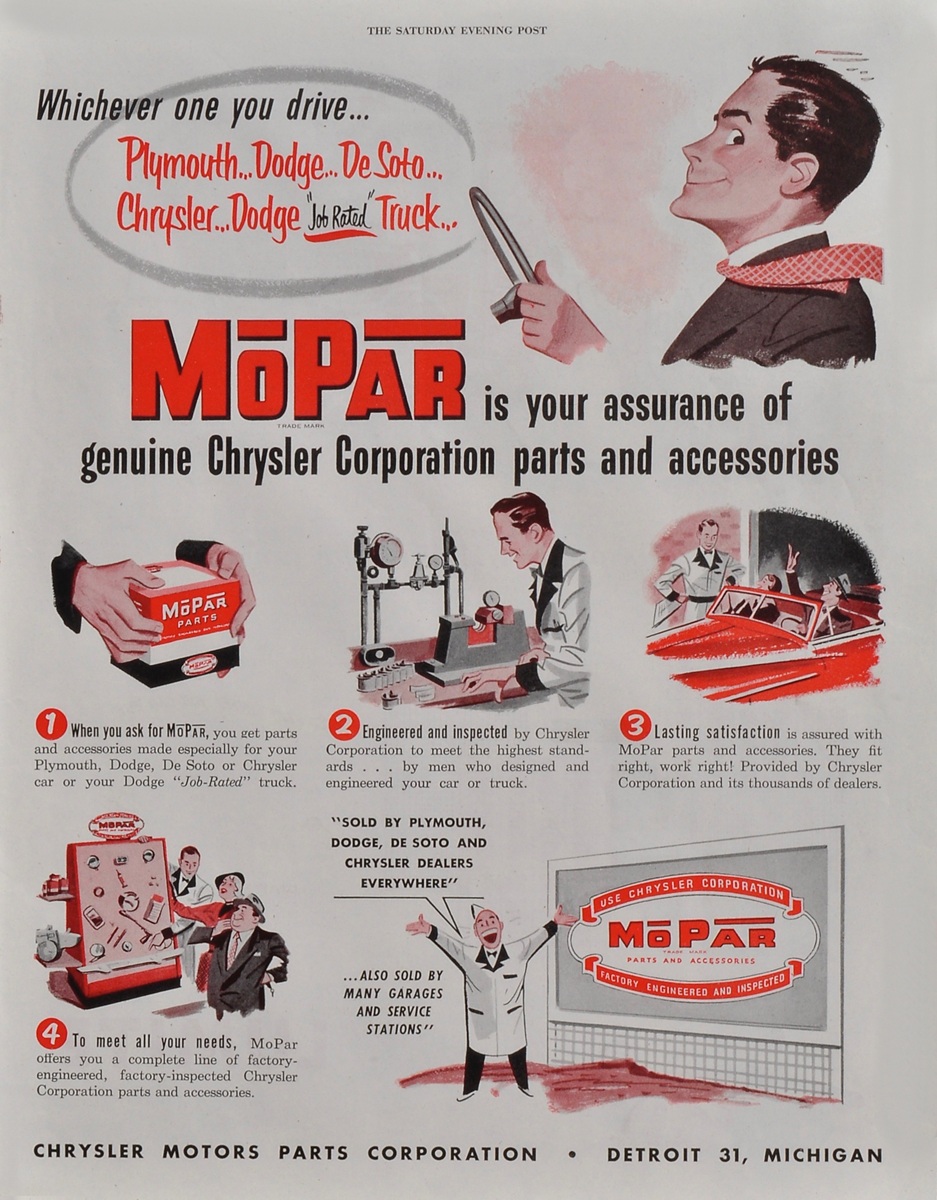
“Provided by Chrysler Corporation and its thousands of dealers. Also sold by many garages and service stations!”
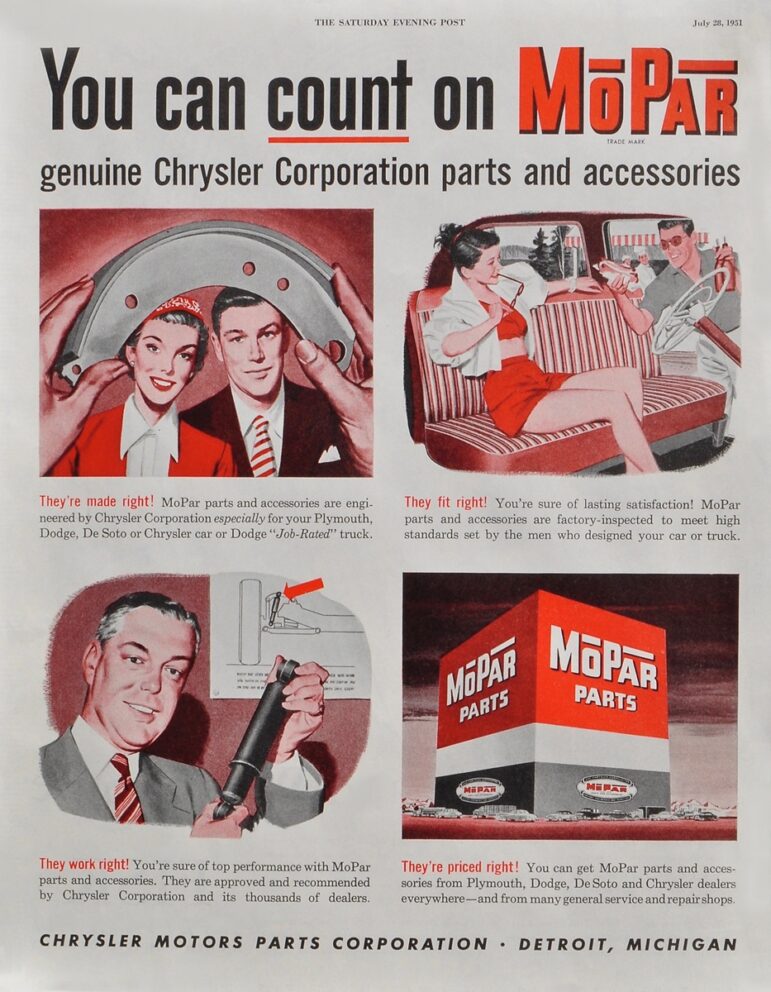

“They’re made right! They fit right! They work right! They’re priced right!”
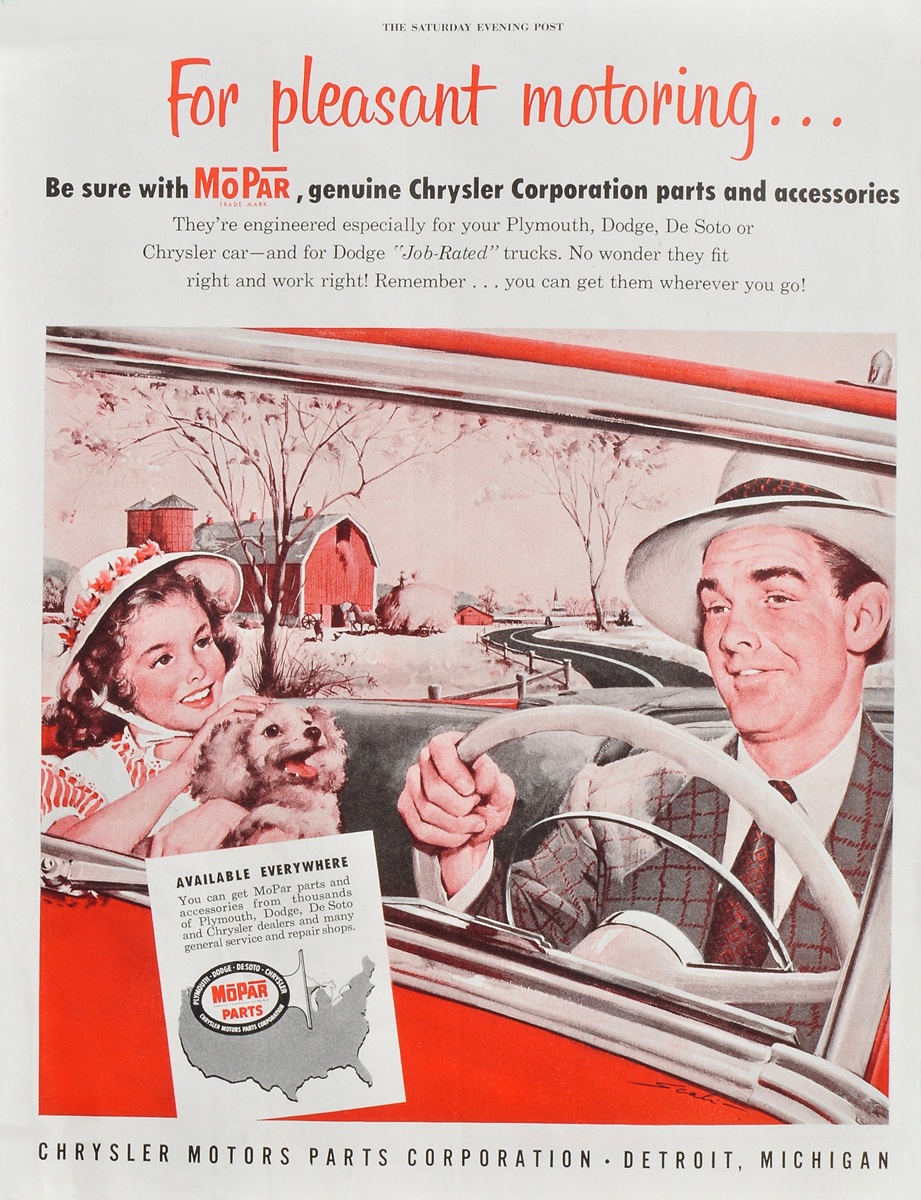
“Remember…you can get them wherever you go!”
1954 UPDATED LOGO
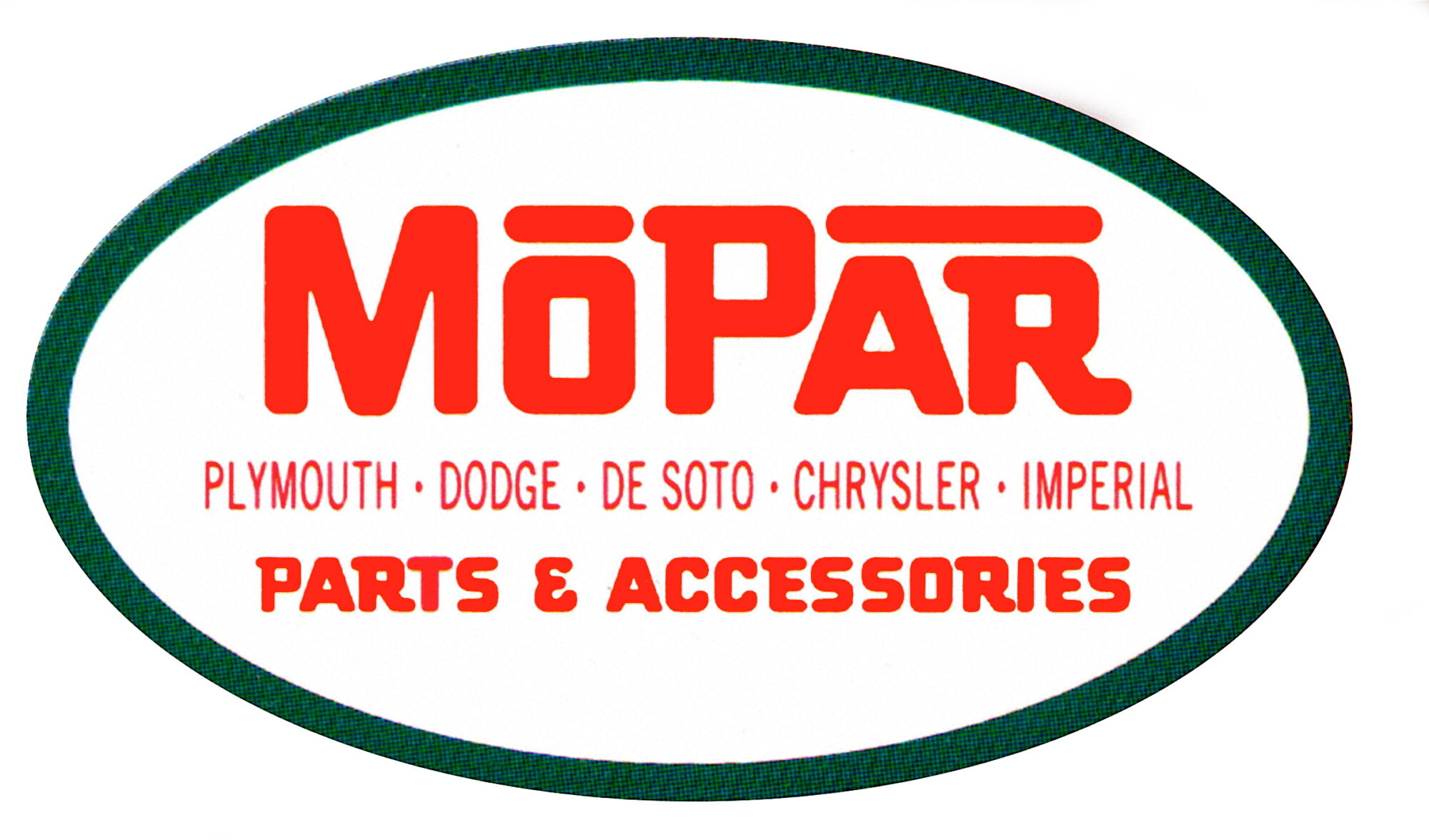
THE BIG SIGN
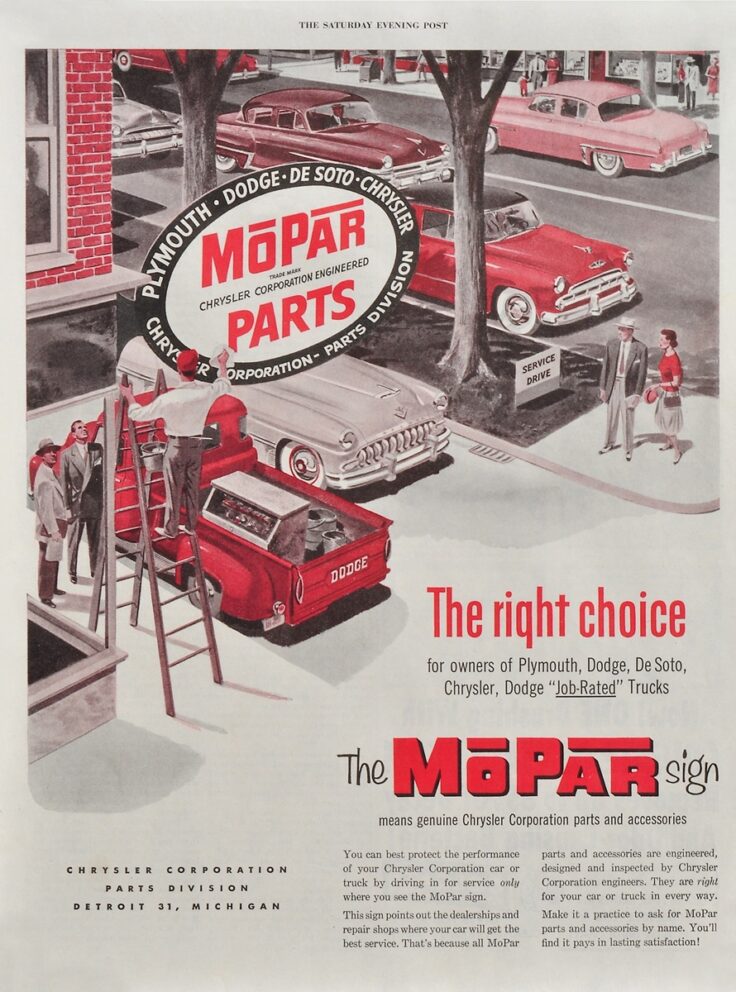
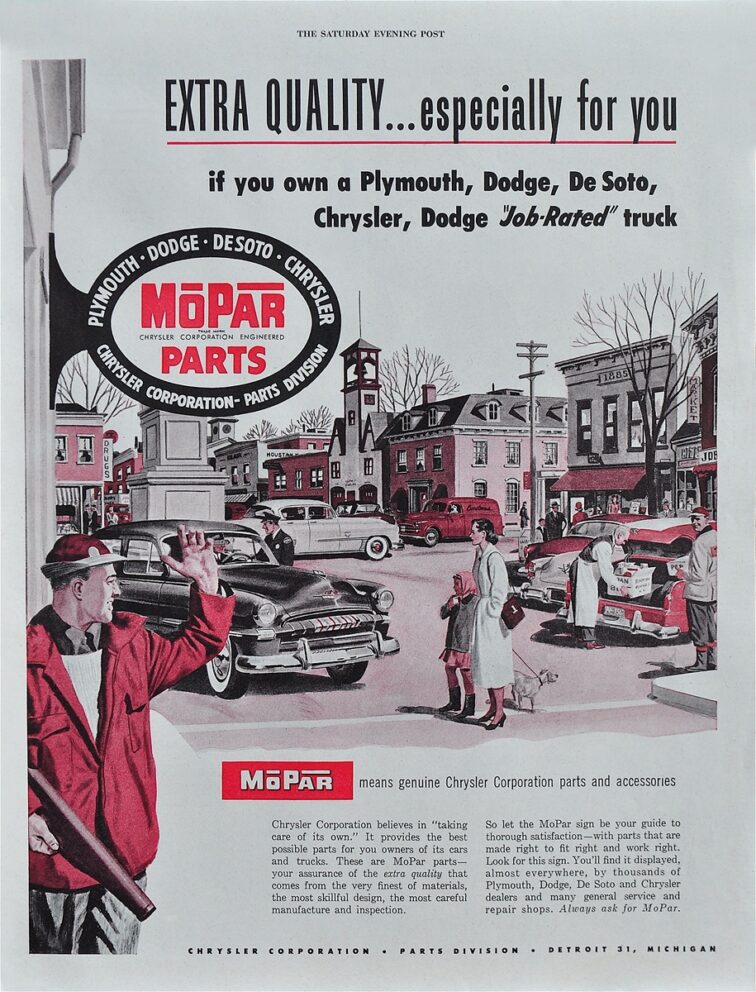
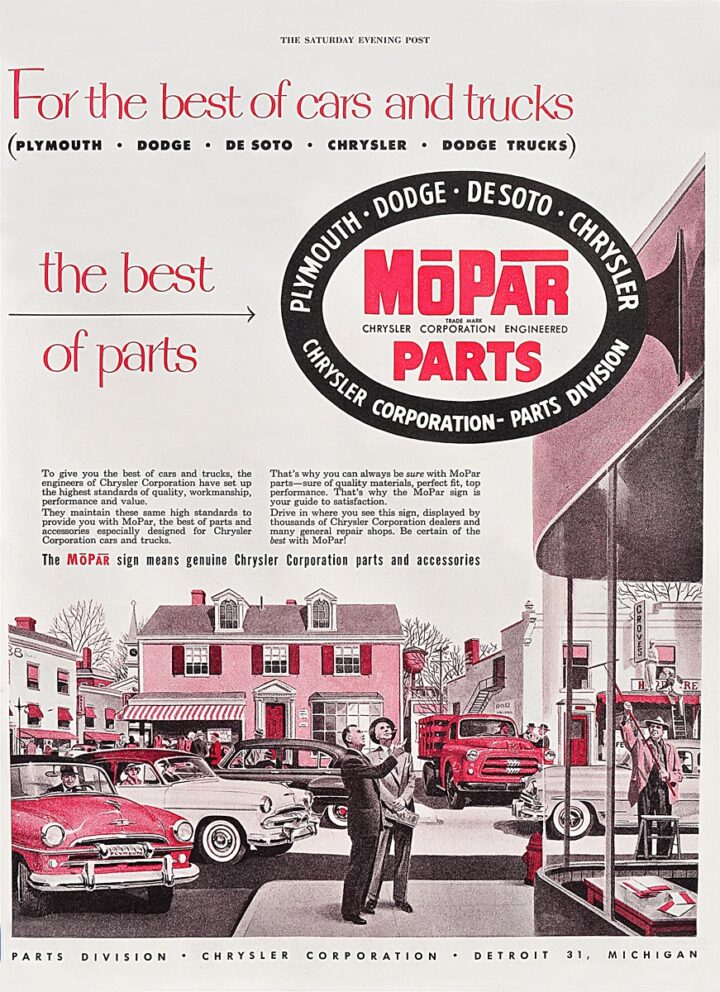
These artsy ads ran in 1953-54 editions of the Saturday Evening Post and stated that the MoPar sign leads to where your car will get the best service and also to “make it a practice to ask for MoPar parts and accessories by name.” Interestingly enough, the logo used in the August ’53 ad placement uses the new for 1954 logo, but with 1953 examples of Chrysler vehicles.
The ad said that “Chrysler takes care of its own” and suggested that readers always ask for MoPar for owners of its cars and trucks. “Look for this sign. You’ll find it displayed, almost everywhere, by thousands of Plymouth, Dodge, De Soto and Chrysler dealers and many general service and repair shops.”
Depicting two men admiring the big and bold “MoPar Parts” sign attached to a Chrysler dealership, the March 20, 1954 ad tells the reader that the MoPar sign is their guide to satisfaction. “Be certain of the best with MoPar!”
TOUTING THE MOPAR ADVERTISING CAMPAIGN
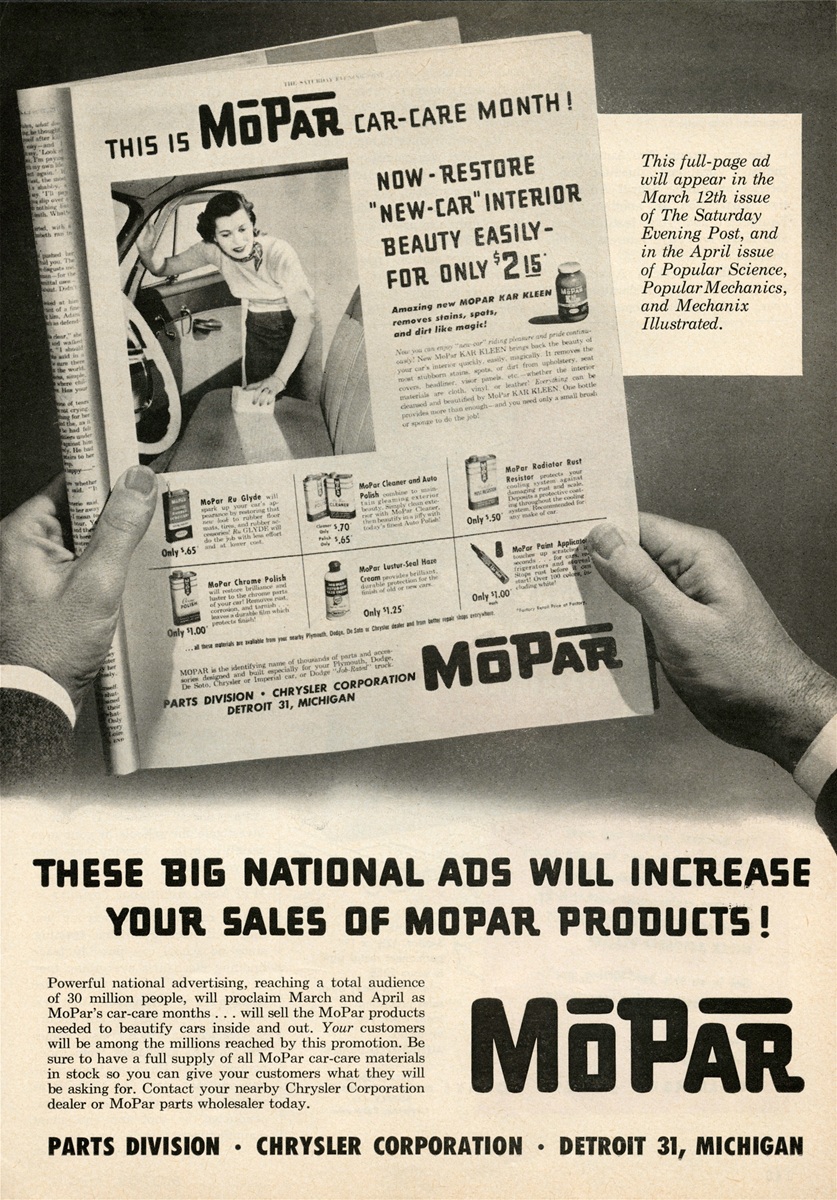
Inside the pages of the April 1955 edition of MOTOR Magazine, this trade advertisement promoted various MoPar products such as bottles of the “MoPar Kar Klean” cleaning solution that was said to amazingly clean away stains, spots and dirt like magic. The message to the parts counter men that handled MoPar products was basically to be on the lookout for an influx of customers that were going to visit their place of business as a result of full-page consumer ads that MoPar had placed (Saturday Evening Post, Popular Science, Popular Mechanics and Mechanix Illustrated publications). The readers were made aware that April was officially “MoPar Car-Care Month!” The woman in the photo seems to be cleaning away a 1/8th-inch layer of heavy dust with a sponge from the front seat of a Chrysler product of the era.
HEMI® ENGINES AND MOPAR HIGH-PERFORMANCE INVOLVEMENT
The Chrysler HEMI® engine added much spark to the MoPar world in a big way when various racers discovered them. There were also racing efforts by Dodge racers as well with their lighter-weight cars (coupled with the Dodge Red Ram HEMI engine), and around this time a Chrysler employee named Brian L. Schram became involved in a new and different aspect of distributing MoPar parts that made their way into the hands of racers. This was the very start, behind-the-scenes of the match-up between MoPar parts and high-performance.
Schram was working in the Product Engineering Office at the company and because the Chrysler and Dodge cars were being raced on the NASCAR stock car circuits, the racers that ran them would need a supply of parts to keep in competition and in the winner’s circle. Stock car racing greats Lee Petty and Carl Kiekhaefer where a couple of the big-name racers that Brian sent parts to (HEMI cylinder heads, intake manifolds, pistons, all the equipment needed to build competition engines) and it was important that they get sent the correct parts and in a timely manner. These racers were factory sponsored and if the factory had made some improvement in the design or construction of the components, they wanted to make sure the racers got them and Brian Schram quickly grew a reputation as being the guy in the company that could get it done. He wasn’t a racer himself or particularly involved in engineering, but he knew the parts business and knew the way around the company to get parts delivered.
1959 LOGO AND ADS
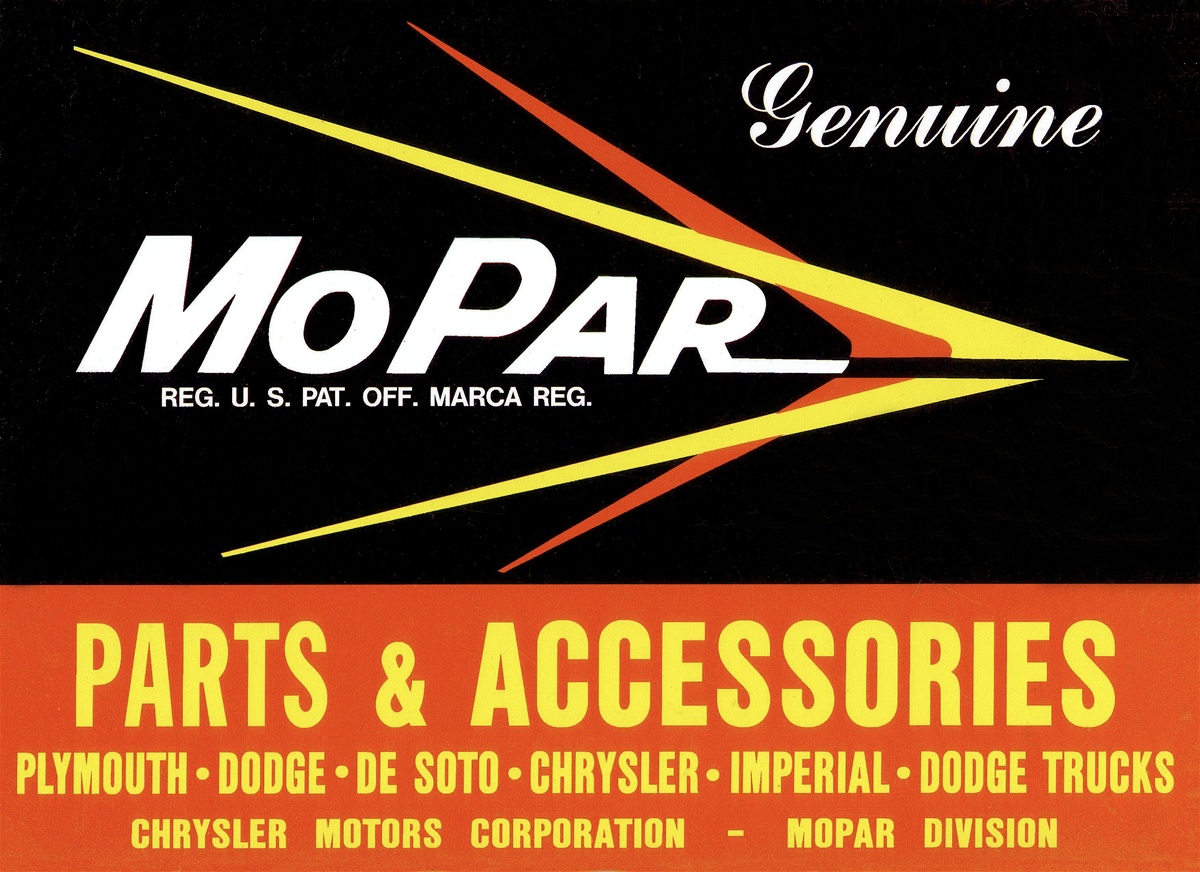
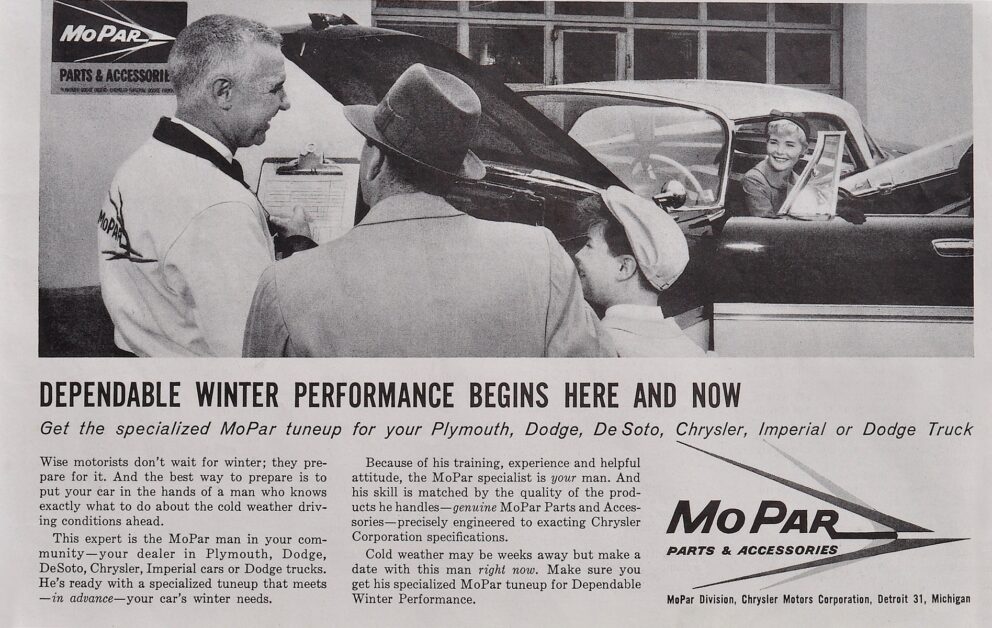
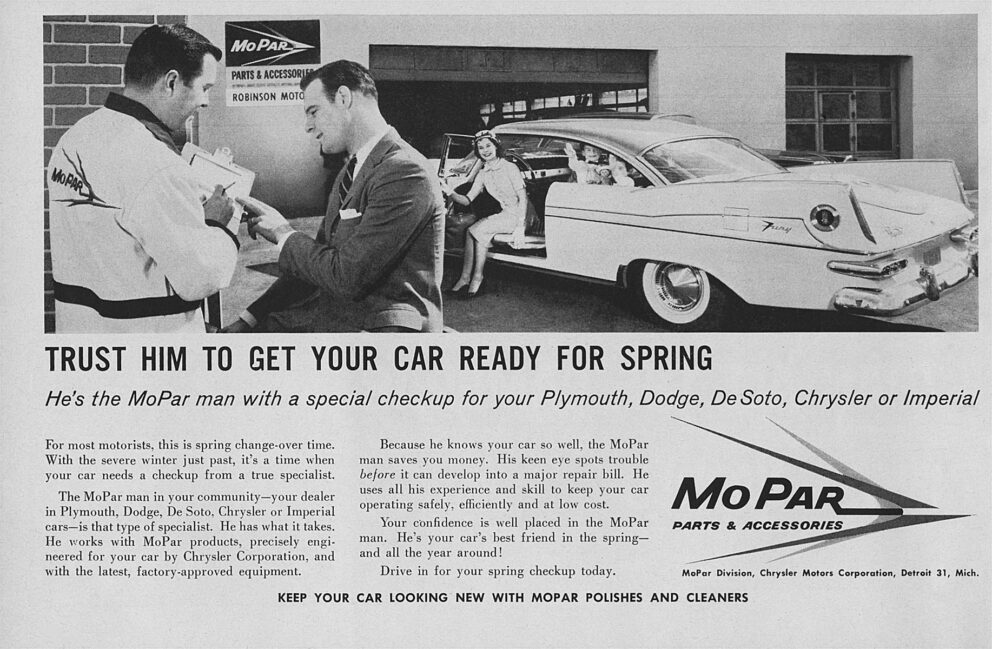
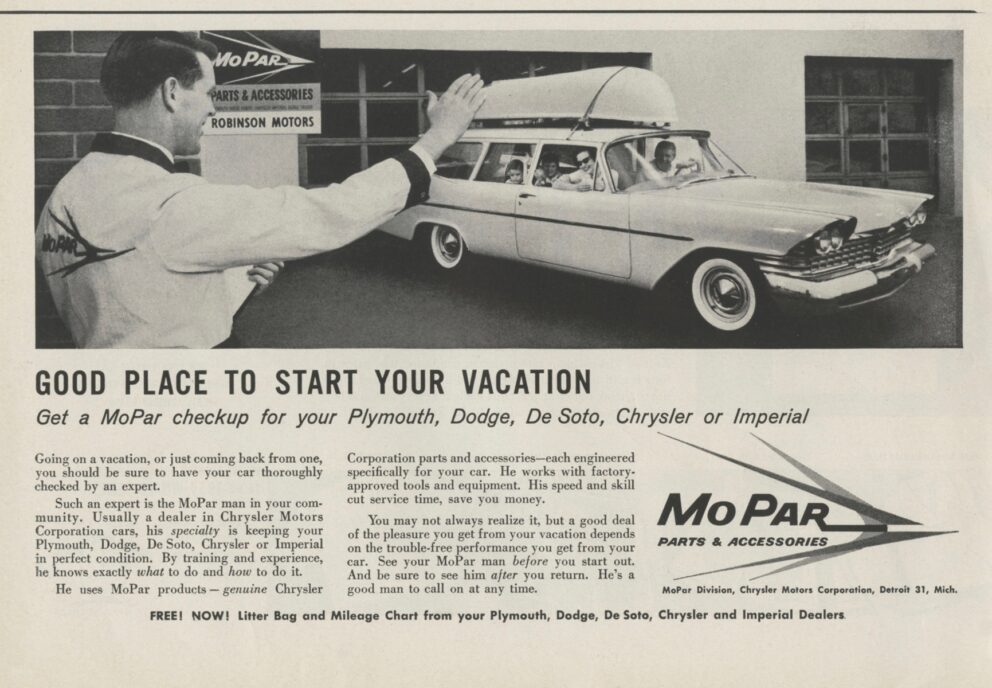
These three 1959 consumer ads highlight tune-ups, service and checkups for motorists, hence featuring current model vehicles. The general message was that “the MoPar man knows your car so well, his keen eye spots trouble before it can develop into a major repair bill.”
DELTA-SHAPED MOPAR LOGO
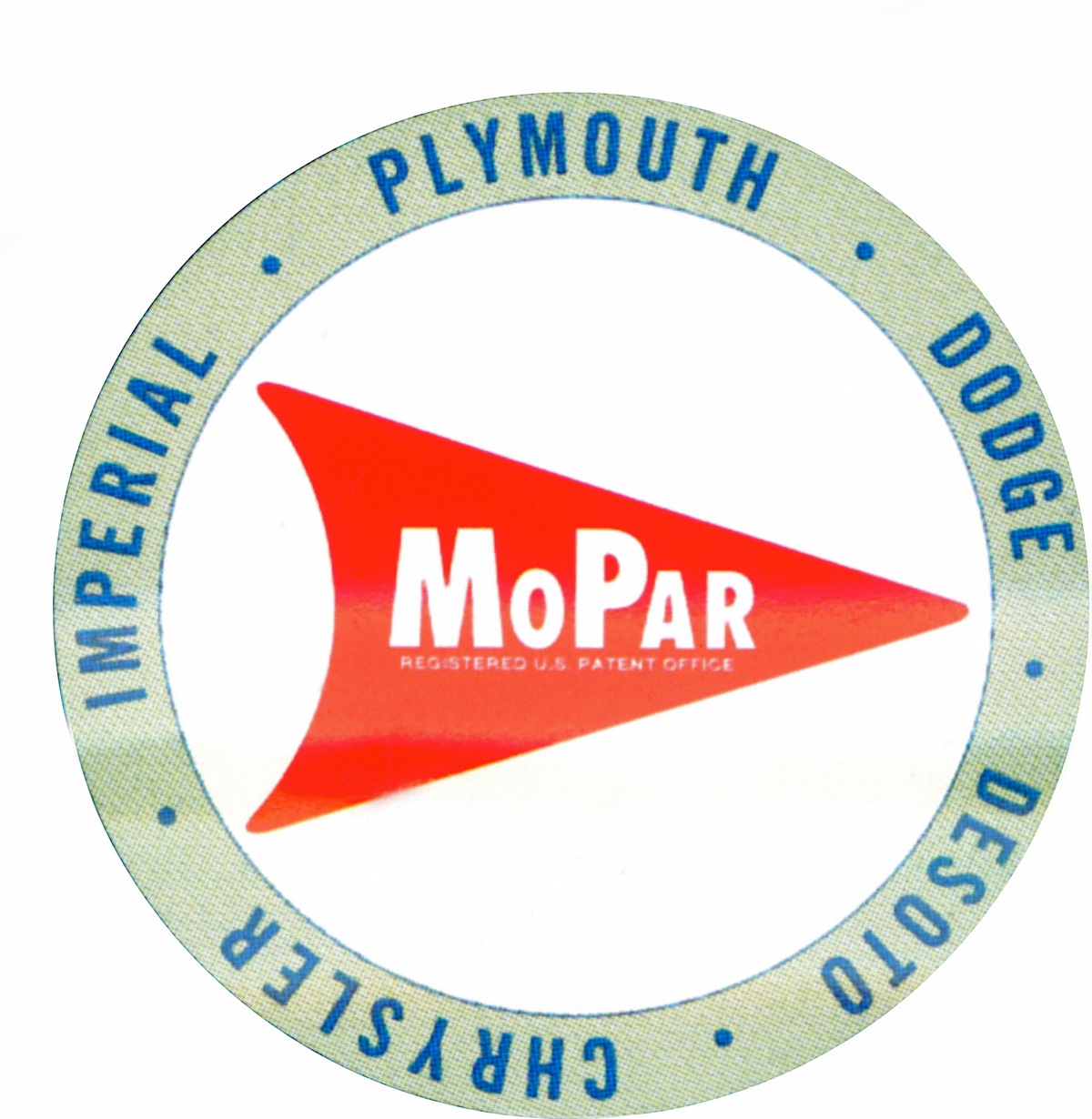
This logo came circa very late 1950s and the version was short-lived (with the listing of the various Chrysler brands) as the demise of DeSoto soon after had taken place, which was discontinued very early during the 1961 model year.
INTRODUCTION OF OMEGA M ON LOGO
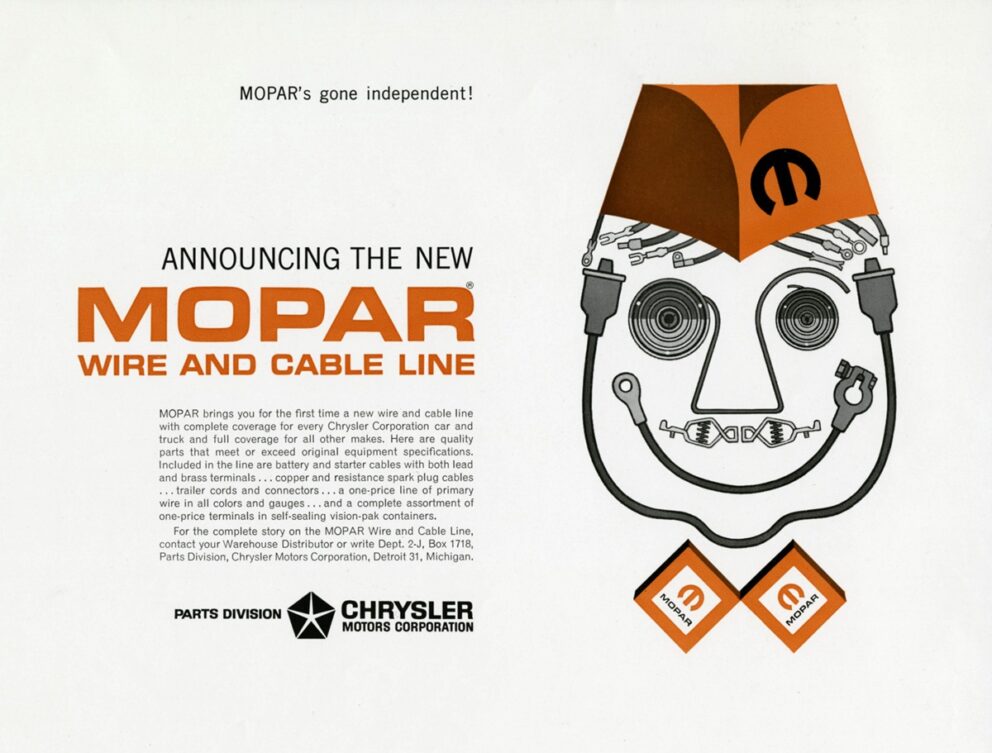
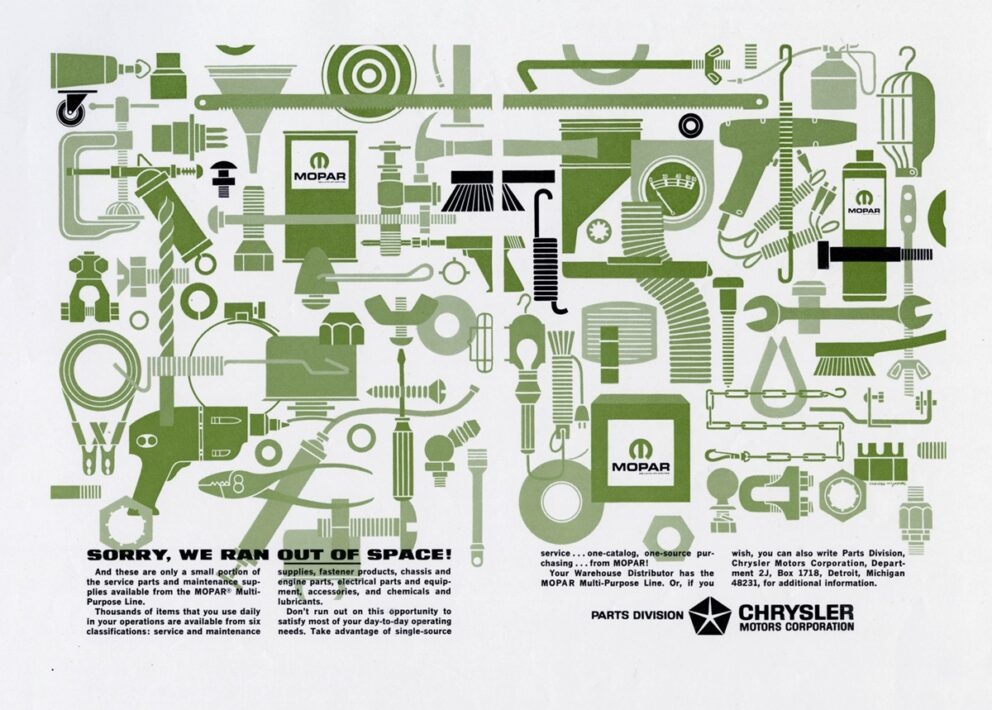
As seen in these mid-1960s Mopar “Service Parts” trade ads, the Omega M symbol was seen for the first time as part of the Mopar identification. Designed by Chrysler artist/designer George Robinson, a simple yet iconic addition to the logo design. To this day, many combinations have been evolved of it and it’s recognized throughout the world.
As evidenced by reviewing the various Mopar trade and consumer ads, racing parts were never promoted in any advertising campaign as it wasn’t a focus. When production of the 392 HEMI Firepower engine stopped at the end of the 1958 model year, it was unclear what, if any, the high-performance scene would be for the corporation. But good things were soon to come!
The 1960s saw Schram become more and more involved in supplying parts to not only NASCAR racers that ran Dodges and Plymouths but also to drag racers from coast to coast, as the introduction of the new 413-cid “Max Wedge” engines once again saw the Chrysler Corporation active in motorsports circles, and the racers needed their parts. Racing was great publicity for Chrysler during this time-frame and supplying the racers with (what were now truly high-performance items from Mopar) components was an important job. And all this activity wasn’t done in secret or with hidden budgets or back-door deals, it was all up front with the head office and actually encouraged by the company president Lynn Townsend.
It turned out that he had teenaged sons that had told their old man that, and it was stated rather accurately, that Dodges and Plymouths were not considered “cool” cars on the boulevard by the youth market (this was circa 1961) and that Pontiac was the big player for those that knew and understood horsepower. As head of the company, Townsend wanted that to change and authorized the building of special parts and pieces to build up the power under the hoods of the Dodge and Plymouth products.
It was right about here that the story of the Mopar Division and its impact into the world of high-performance takes a twist and turn and this time around it happened because of yet another division (located away from Detroit in the town of Marysville, MI) that went by the name of “Marine and Industrial Engine Division.”
It is important to note that at Chrysler, as well as at the other car manufacturer headquarters (as in mainly Pontiac, Chevrolet and Ford), many of the most loyal employees were themselves “car fanatics” and loved racing and all the excitement of the high-performance world. They took pride in the brand of car that they worked for and in many cases, street raced at places like Woodward Avenue (Detroit area) or on sanctioned drag strips with their cars. They ate, slept and breathed fast cars and would go the extra distance at work if it was relating to racing and all the excitement that went along with it!
One example of this kind of enthusiasm was from an engineer of the Marine and Industrial Division named Peter Dawson. While perhaps not as well known to the masses as the Chrysler employees, for example, that were involved with the “Ramchargers” and “Golden Commandos” car clubs, Dawson was active himself with fast cars while he worked at Chrysler, and in the early 1960s that scene was starting to really take off with the Dodge and Plymouth products in the way of the 413-cid Max Wedge engines. Marine and Industrial was where the special 413 mills were built and eventually distributed to the then-current racers.
Pete Dawson knew that the street warriors would also want to get their hands on these hot 413-cid engines so he started to think about a way to get the message out to regular guys, not just the big-name sponsored factory racers that were able to get these engines for competition use. And as a reader of Hot Rod Magazine, he brainstormed the idea to run a mail-order type ad in the publication to get the word out. He wasn’t representing “Mopar” or the racing divisions per se, he was thinking about this on his own as an engineer for the Marine and Industrial Division. Clearly this was something he wanted to do and it was a true testament to his enthusiasm in racing, plus pride in seeing the expansion of Chrysler products in high-performance circles, be it on the race track or on the street!
MAXIMUM PERFORMANCE PACKAGES ADVERTISEMENT
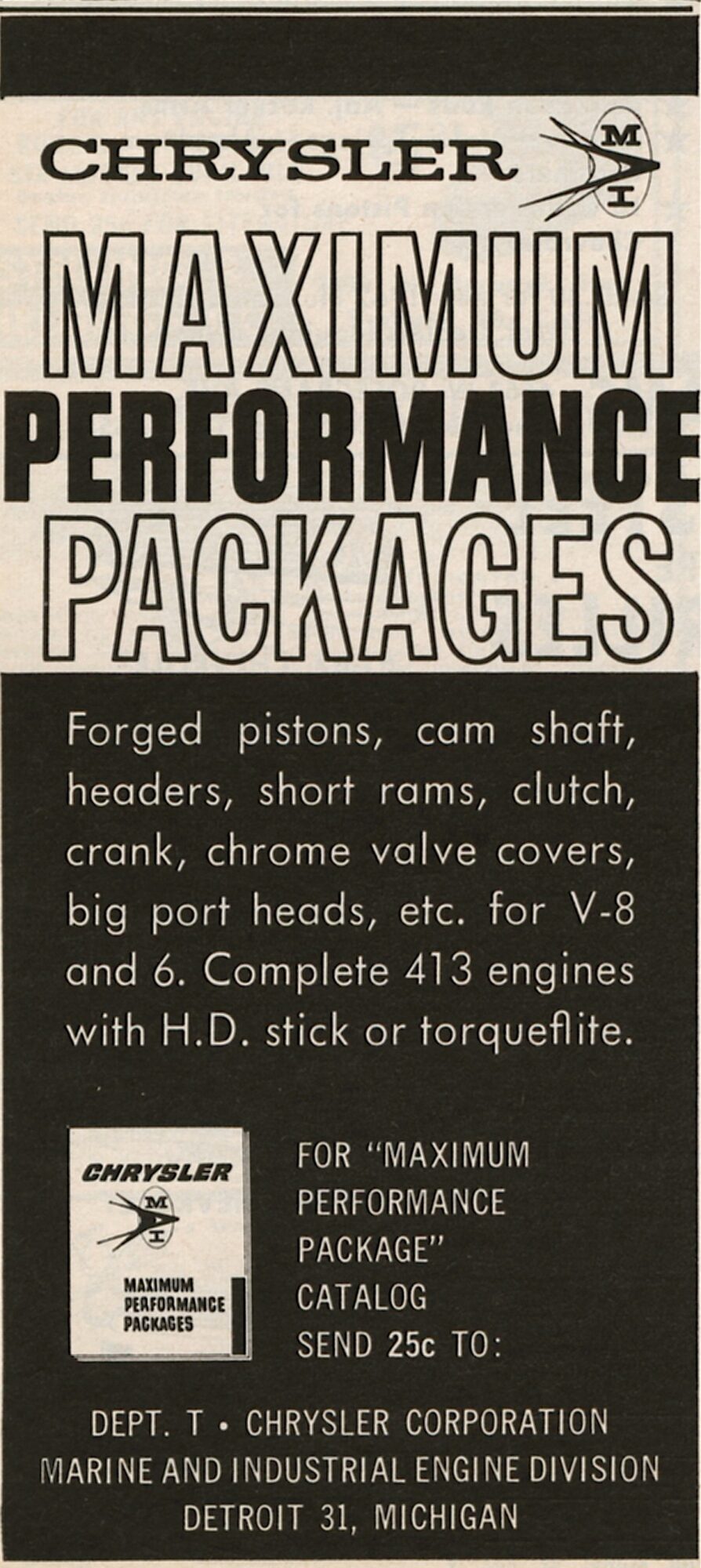
What happened next was trying to convince his boss to give the go-ahead on running a small advertisement in the popular car magazine. Here’s how he explained it to Roger Meiners of the factory publication Mopar Magazine which was published by the long-time Chrysler ad agency J.R. Thompson: “There were a number of unique parts for the 413 drag race engine – the camshaft, the chrome valve covers, the two 4-bbl manifold, headers, windage tray, a lotta stuff. My boss said, ‘OK, what do you need to get started?’ and I told him I needed to run an ad in Hot Rod Magazine, and I needed a little brochure. He called over the controller, a nice guy named Ken Templin. Ken wanted to know how we were going to pay for all this. I said, ‘Well, I’m going to charge a quarter for the brochure.’ He thought that was OK, but wanted to know what was going to happen to those quarters.”
MAY 1962 HOT ROD MAGAZINE
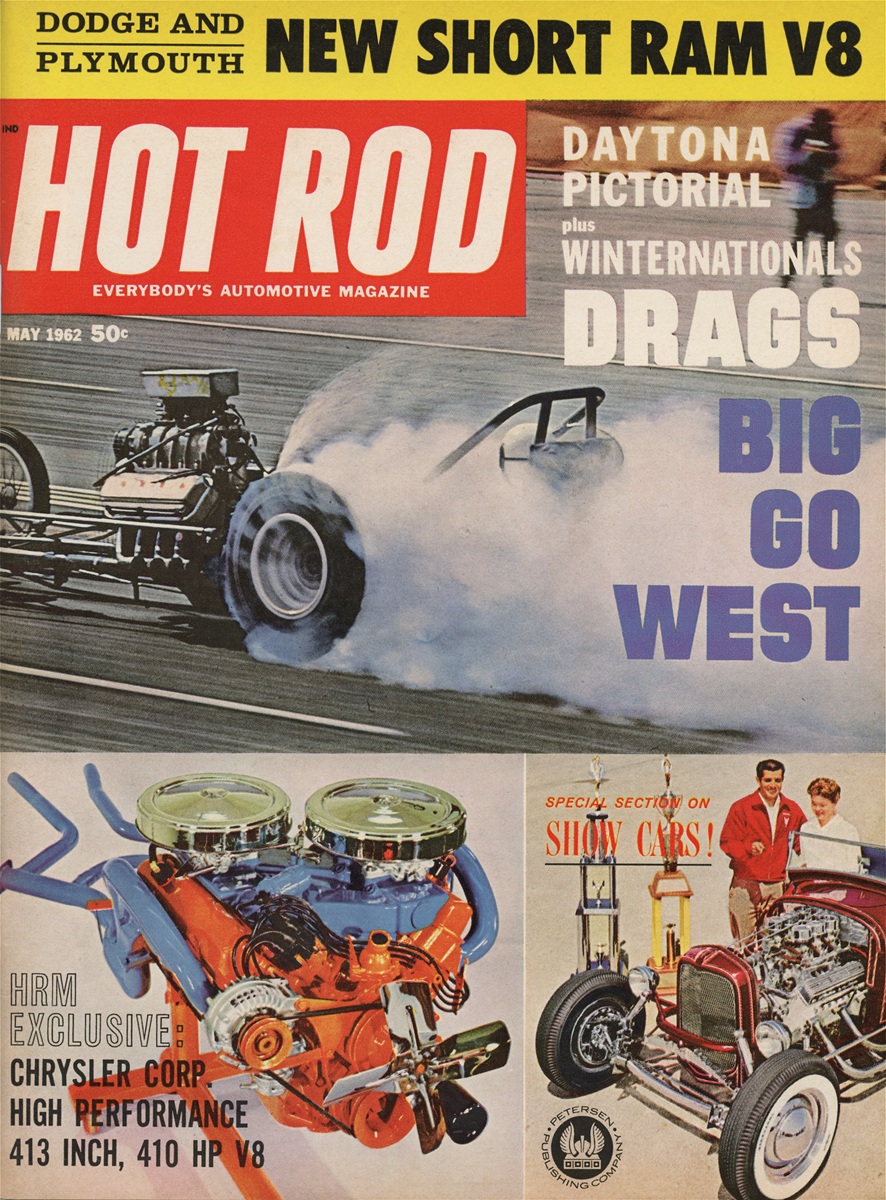
The long and the short of it was that Pete Dawson was able to run that ad in the magazine; however, it took some eight weeks for it to happen because of the standard lead times involved in publishing. And, to his benefit, a lot had happened in those weeks as far as the editorial department of the magazine (Ray Brock) visiting Chrysler’s Central Engineering Department! Hot Rod had gotten wind of these new engines and for a scoop in their May 1962 issue of the magazine, they had made the trip from from California to Michigan to check out the new line of 410-hp (11:1 compression ratio) and 420-hp (13.5:1 compression ratio) 413 Super Stock engines. The visit resulted in an exclusive Hot Rod Magazine color cover shot of one of the highly detailed display engines, along with a lengthy 8-page layout detailing all the engineering advancements of these hot new high-performance Dodge/Plymouth V8 powerplants.
Here’s how Brock summarized the situation: “From what we have just seen during a trip to Chrysler’s Central Engineering department in Detroit, there should be an abrupt change in the kind of impression Dodge and Plymouths make on the drag strips starting just about the time this magazine hits the newsstands. The latest efforts of Chrysler Engineers produce a wild-looking, strong running 413-inch engine destined to make Dodge and Plymouth cars the hottest things on the strip.”
Ken Templin, that company controller who was concerned about the quarters, was in for a big surprise! As they say, “timing is everything” and the placement of that ad in the back of Hot Rod came at the perfect time (based on all the coverage and high praises given to the 413s by the magazine) for a great response from the readers. As soon as that issue hit the stands, the postman entered the offices of the Marine and Industrial Division with a duffel bag full of letters of request for that brochure: “Maximum Performance Packages” and along with them were the quarters, lots and lots of quarters! Because of the mention of where all the quarters were going to go, when Pete placed the ads the address stated to mail the quarters to “Department “T” (which stood for Templin!) so when the mailman arrived, he asked where Department T was located? (It turned out to be on Ken Templin’s secretary’s desktop.) She had to stop everything she was doing and start processing all those letters, the phones were not getting answered and all the normal typing wasn’t getting done, and then the next day, two duffel bags accompanied the mailman and it was obvious that the general readership of Hot Rod Magazine was very interested in what Chrysler was doing with their new high-hp engines, and was more than willing to send in 25 cents to find out more information.
“Of course it took eight weeks for it to appear in the magazine [the May 1962 issue],” recalled Dawson in the interview with Meiners. “But by that time, we had all the parts made up in groups, so that when a guy ordered a valve cover, he also got a valve cover gasket and the chrome nuts and everything he needed. And so we had that all put together – 24 or 28 packages. Mopar didn’t do things that way at the time. The customer had to know what was needed and all the parts had to be ordered separately. Instead, we were going to send the guy the whole package and he didn’t have to know all those parts. We knew what he needed – and we were going to give instant service.”
Well, of course, the ad placement in Hot Rod Magazine was a totally brilliant idea, and as luck would have it, it was also so successful that the Mopar headquarters had heard all about it and soon a meeting took place, with Peter Dawson requested to attend! It seems the big wigs at the corporation really liked the whole idea, but they pointed out that the charter for the company only allowed for Mopar to actually sell parts so they took that over, and the guy in Detroit that was given the responsibility to take it over was Brian Schram, the one who had great experience with racing and high-performance from years past. And after the 413 Max Wedge came the 426 Max Wedge; then during 1964, the 426 HEMI engines were released, so Schram surely had lots of goings on with the new project!
It was also in 1964 that the word MoPar was changed to “Mopar” and the roundish Greek-type Omega M was added to the brand identification.
CONSUMER AD WITH 1964 426 RACE HEMI
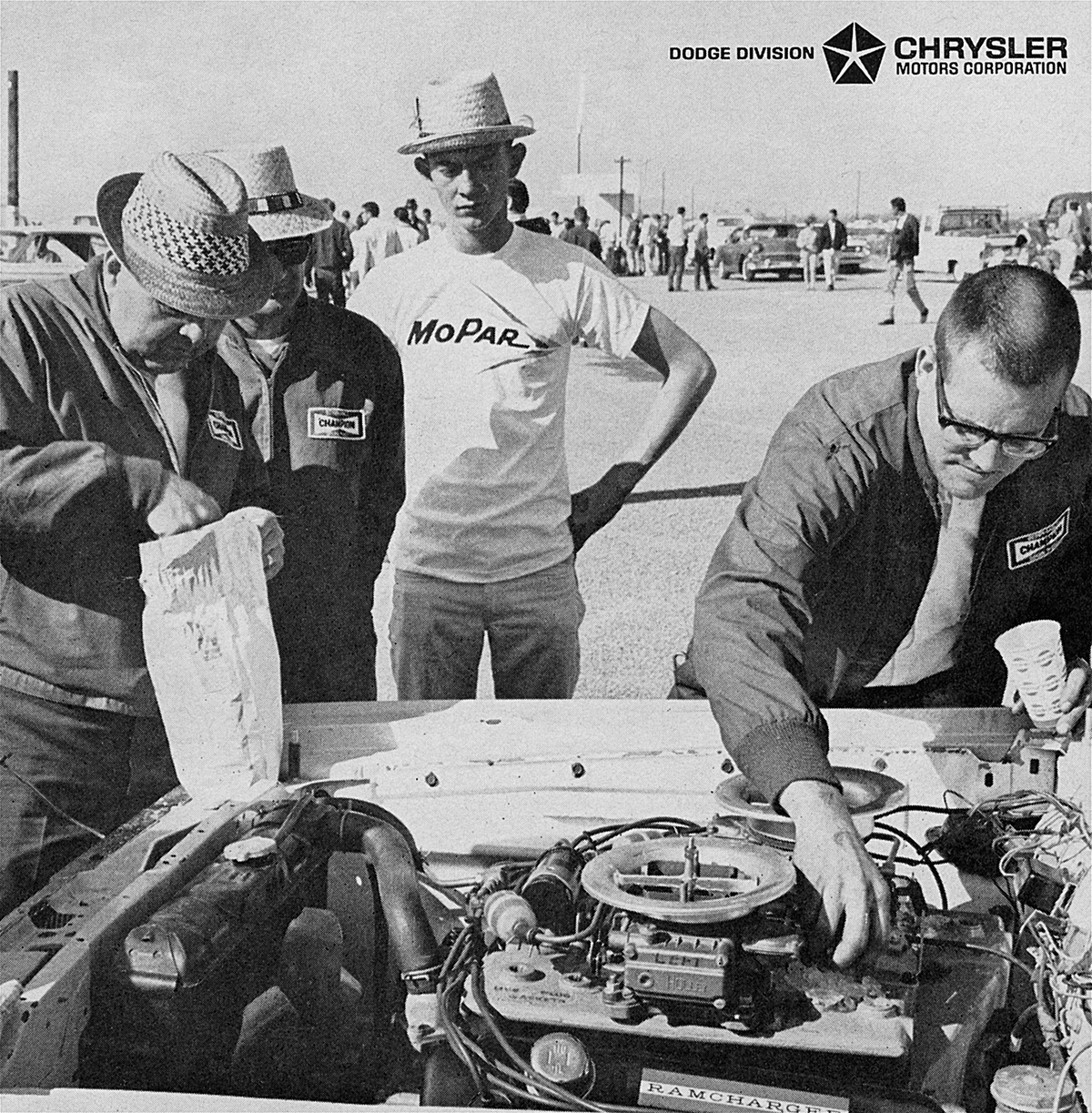
Icing down the cross-ram intake on a Super Stock Dodge, this 1964 promotional advertisement included a bystander wearing a MoPar shirt, an early subliminal way to send the message that Chrysler products were very much known as hot cars!
NEXT UP: A NEW LOOK FOR MOPAR AND EXPANSION IN THE MARKETPLACE
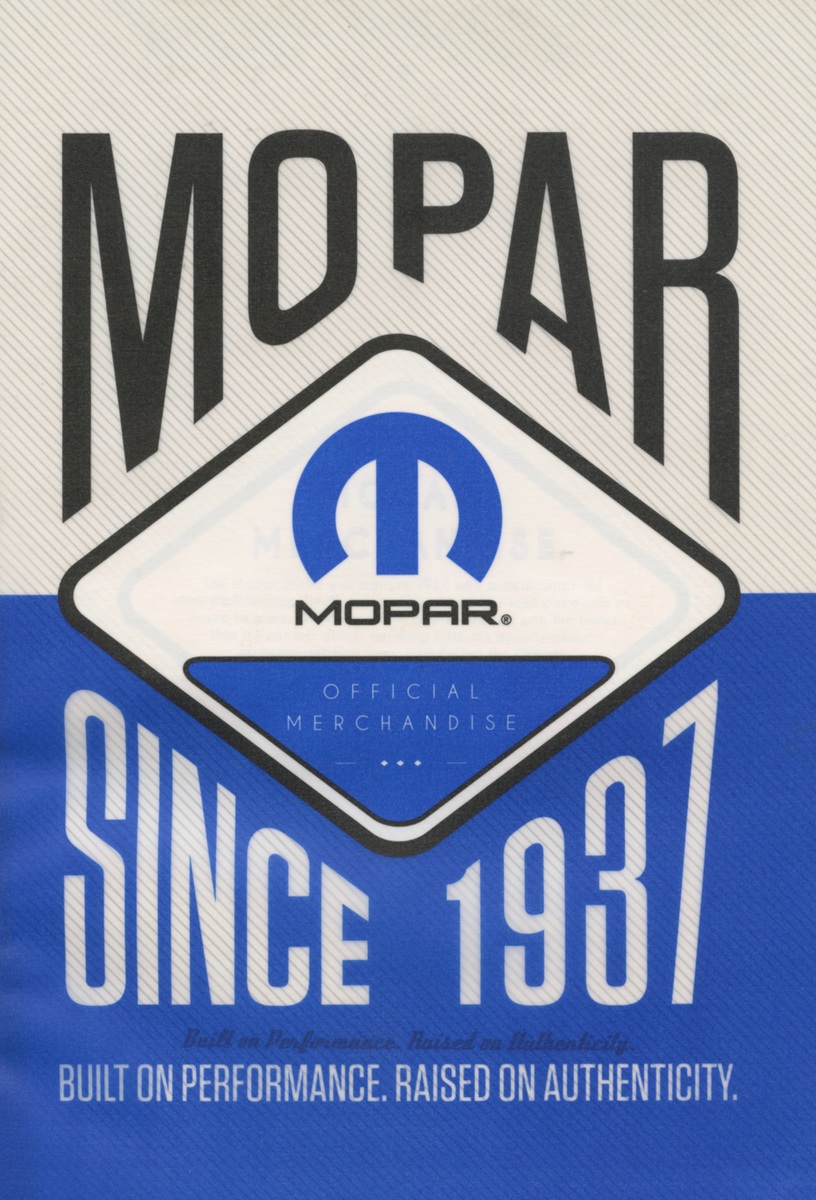
Author: James Maxwell
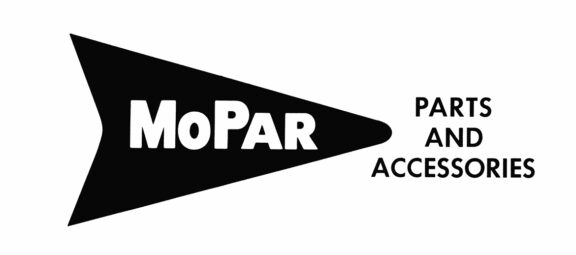
0 Comments